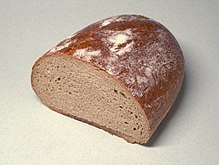Consumer bread
The consumer bread was a subsidized mixed rye bread in post-war Germany .
With the end of the war, the demand for white wheat bread increased in Germany , while rye flour was hardly ever used. At the same time, bread prices rose after being released in June 1950 under pressure from the High Commissioners . To compensate for this, in July 1950 the German government introduced a mixed bread made of rye and wheat called consumer bread or rye bread , for which a price of 50 pfennigs per kilogram was set.
The state first subsidized the flour mills with two million marks and obliged them to sell the rye flour to the bakers at a prescribed price in order to maintain the price of the consumer bread. Later, the state no longer subsidized rye flour, but instead compensated for the price increases that resulted from increased flour prices and operating costs with a subsidy for every consumer bread.
The German government spent a total of 446 million marks on subsidizing consumer bread, which was finally abolished on February 15, 1953. In West Berlin , where the subsidy continued until March 1958, it cost an additional 94 million marks. 37 million had to be repaid to the state for subsidy fraud .
swell
- ↑ a b Klaus-Peter Schmid: "50 Pfennig the Kilo". (No longer available online.) In: Die Zeit . May 28, 2003, formerly in the original ; accessed on December 1, 2015 . ( Page no longer available , search in web archives ) Info: The link was automatically marked as defective. Please check the link according to the instructions and then remove this notice.
